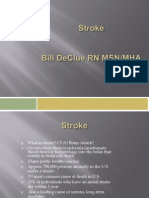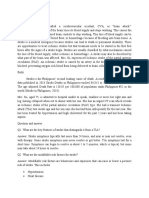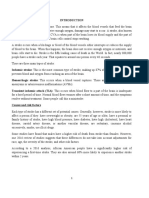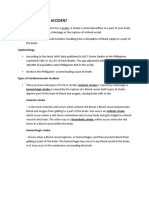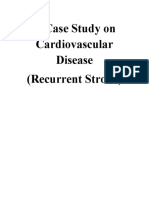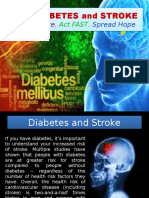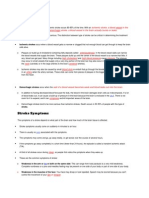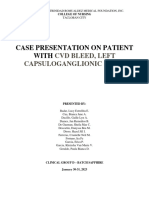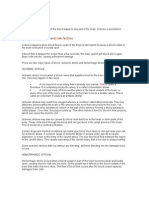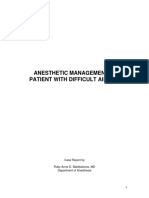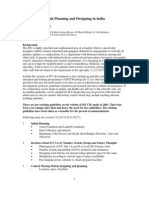The Pathophysiology of Ischemic Strokes Is Widely Known. Ischemic Strokes Are The
The Pathophysiology of Ischemic Strokes Is Widely Known. Ischemic Strokes Are The
Uploaded by
prnczb13Copyright:
Available Formats
The Pathophysiology of Ischemic Strokes Is Widely Known. Ischemic Strokes Are The
The Pathophysiology of Ischemic Strokes Is Widely Known. Ischemic Strokes Are The
Uploaded by
prnczb13Original Title
Copyright
Available Formats
Share this document
Did you find this document useful?
Is this content inappropriate?
Copyright:
Available Formats
The Pathophysiology of Ischemic Strokes Is Widely Known. Ischemic Strokes Are The
The Pathophysiology of Ischemic Strokes Is Widely Known. Ischemic Strokes Are The
Uploaded by
prnczb13Copyright:
Available Formats
1. The Pathophysiology of ischemic strokes is widely known.
Ischemic strokes are the most common type of stroke contributing to over 80 percent of stroke cases. Ischemic strokes are caused by blood clots that subsequently deprive parts of the brain from blood flow and oxygen resulting in the death of brain cells and tissue and a stroke. There are many factors that can affect the buildup of a blood clot resulting in a stroke. The chance of an ischemic stroke is largely affected by several main factors including: age, family history, systolic blood pressure, smoking, alcohol, myocardial disease, diabetes and atrial fibrillation. In terms of the Pathophysiology of ischemic stroke age and systolic blood pressure are the most influential factors in ischemic strokes. +Hemorrhagic strokes are the second most common type of stroke and are caused due to a burst blood vessel either within the brain itself or just outside of it. There are two main types of hemorrhagic strokes each with different Pathophysiology. One type of hemorrhagic stroke is an intracranial hemorrhage. This type occurs within the brain or in the area surrounding the brain. The bleeding in an intracranial hemorrhage occurs directly into the brain and subsequently the surrounding brain can be damaged by the increase pressure imposed by the mass effect of the burst blood vessel. The main causes of hemorrhagic strokes include: systolic blood pressure, age and anticoagulation. High blood pressure is the main cause of both hemorrhagic and ischemic strokes. Some of the less common causes of hemorrhagic strokes include: cranial trauma, tumors, hypertensive hemorrhages and vasculitides all of which can lead to a buildup of blood around the brain causing a hemorrhagic stroke. 2. Risk factors for ischemic attack are smoking, high blood pressure, high cholesterol, and diabetes as well as family history Also, any condition that results in stagnant blood flow and or clotting may result in a TIA due to embolization of a blood clot. Such conditions may include atrial fibrillation, large heart attacks, and severe weakness of the heart muscle. Risk factors for hemorrhage attack Age ,Gender, Ethnicity, Presence of Other Vascular Disease, Abnormal Blood Pressure, Heart Abnormalities Causing Traveling Blood Clots (Embolisms), Smoking, Diabetes and Insulin Resistance, Obesity and Metabolic Syndrome, Cholesterol and Other Lipids, Genetic and Inborn Factors, Inherited Disorders that Contribute to Stroke, Stress, Depression, Infections and Inflammation, Peripheral Artery Disease, Non-Steroidal Anti-Inflammatory Drugs (NSAIDs)
3. Signs and symptoms for ischemic attack
Hemiparesis
Facial weakness Arm weakness Leg weakness Confusion Speech problems
Slurred speech Difficulty talking Difficulty understanding speech
Vision disturbances Trouble seeing in one eye Trouble seeing in both eyes
Difficulty walking Dizziness Loss of balance Loss of coordination Blurred consciousness No loss of consciousness Loss of consciousness
Signs and symptoms for hemorrhagic attack
Weakness or inability to move a body part Numbness or loss of sensation Decreased or lost vision (may be partial) Speech difficulties Inability to recognize or identify familiar things Sudden headache Vertigo (sensation of the world spinning around) Dizziness Loss of coordination Swallowing difficulties Sleepy, stuporous, lethargic, comatose, or unconscious
4. Treatment of a CVA A stroke is a medical emergency. Immediate treatment can save lives and reduce disability. Call 911 or your local emergency number or seek immediate medical care at
the first signs of a stroke. It is important to get the person to the emergency room immediately to determine if the stroke is due to bleeding or a blood clot so appropriate treatment can be started within 3 hours of when the stroke began . Treatment depends on the severity and cause of the stroke. A hospital stay is required for most strokes. Treatment in Hospital Clot-busting drugs (thrombolytic therapy) may be used if the stroke is caused by a blood clot. Such medicine breaks up blood clots and helps restore blood flow to the damaged area. However, not everyone can receive this type of medicine.
For these drugs to work, a person must be seen and treatment must begin within 3 hours of when the symptoms first started. A CT scan must be done to see whether the stroke is from a clot or from bleeding. If the stroke is caused by bleeding rather than clotting, clot-busting drugs (thrombolytics) can cause more bleeding. Blood thinners such as heparin or warfarin (Coumadin) are used to treat strokes due to blood clots. Aspirin of clopidogrel (Plavix) may also be used. Other medications may be needed to control other symptoms, including high blood pressure. Painkillers may be given to control severe headache. In some situations, a special stroke team and skilled radiologists may be able to use angiography to highlight the clogged blood vessel and open it up. For hemorrhagic stroke, surgery is often required to remove blood from around the brain and to repair damaged blood vessels. Surgery on the carotid artery may be needed. See also Carotid artery disease and Carotid artery surgery.
Other treatments depend on the cause of the stroke:
Nutrients and fluids may be necessary, especially if the person has swallowing difficulties. These may be given through a vein (intravenously) or a feeding tube in the stomach (gastrostomy tube). Swallowing difficulties may be temporary or permanent. Physical therapy, occupational therapy, speech therapy, and swallowing therapy will all begin in the hospital. Long-Term Treatment The goal of long-term treatment is to help the patient recover as much function as possible and prevent future strokes. The recovery time and need for long-term treatment differs from person to person. Depending on the symptoms, rehabilitation may include:
Occupational therapy Physical therapy Speech therapy
Therapies such as repositioning and range-of-motion exercises can help prevent
complications related to stroke, such as infection and bed sores. Those who have had a stroke should try to remain as active as physically possible. Alternative forms of communication such as pictures, verbal cues, and other techniques may be needed in some cases. Sometimes, urinary catheterization or bladder and bowel control programs may be needed to control incontinence. A safe environment must be considered. Some people with stroke appear to have no awareness of their surroundings on the affected side. Others show indifference or lack of judgment, which increases the need for safety precautions. Caregivers may need to show the person pictures, repeatedly demonstrate how to perform tasks, or use other communication strategies, depending on the type and extent of the language problems. In-home care, boarding homes, adult day care, or convalescent homes may be required to provide a safe environment, control aggressive or agitated behavior, and meet medical needs. Family counseling may help in coping with the changes required for home care. Visiting nurses or aides, volunteer services, homemakers, adult protective services, and other community resources may be helpful. Legal advice may be appropriate. Advance directives, power of attorney, and other legal actions may make it easier to make ethical decisions regarding the care of a person who has had a stroke.
5. Describe the components of a full neurological assessment. Health history, mental status, cranial nerve function, motor function, loc, sensory function, cerebellar function, reflex function, gait and stance 6. How are the results of a head CT used to determine therapy in the patient with CVA? Ct scan determines type of stroke, size and location of hematoma, presence or absence of ventricular blood and hydrocephalus. 7. Discuss the use of rtPA (Alteplase). Treats acute ischemic strokes to help breakdown clots. (clot buster) In order to consider tPA administration:1. Ischemic stroke onset within 3 hours of drug administration. 2. Measurable deficit on NIH Stroke Scale examination. 3. Patient's computed tomography (CT) does not show hemorrhage or nonstroke cause of deficit.
4.
Patient's age is >18 years.
Do NOT administer tPA if any of these statements are true:1. Patient's symptoms are minor or rapidly improving. 2. Patient had seizure at onset of stroke. 3. Patient has had another stroke or serious head trauma within the past 3 months. 4. Patient had major surgery within the last 14 days. 5. Patient has known history of intracranial hemorrhage. 6. Patient has sustained systolic blood pressure >185 mmHg. 7. Patient has sustained diastolic blood pressure >110 mmHg. 8. Aggressive treatment is necessary to lower the patient's blood pressure. 9. Patient has symptoms suggestive of subarachnoid hemorrhage. 10. Patient has had gastrointestinal or urinary tract hemorrhage within the last 21 days. 11. Patient has had arterial puncture at noncompressible site within the last 7 days. 12. Patient has received heparin with the last 48 hours and has elevated PTT. 13. Patient's prothrombin time (PT) is >15 seconds. 14. Patient's platelet count is <100,000 uL. 15. Patient's serum glucose is <50 mg/dL or >400 mg/dL. If either of the following statements is true, use tPA with caution:1. Patient has a large stroke with NIH Stroke Scale score >22. 2. Patient's CT shows evidence of large middle cerebral artery (MCA) territory infarction 8. Discuss the management of the patient who deteriorates neurologically due to a CVA. goal is to stabilize the patient and to complete initial evaluation and assessment, including imaging and laboratory studies, within 60 minutes of patient arrival. Critical decisions focus on the need for intubation, blood pressure control, and determination of risk/benefit for thrombolytic intervention. Time IntervalTime Target Door to doctor10 min Access to neurologic expertise15 min Door to CT scan completion25 min Door to CT scan interpretation45 min Door to treatment60 min Admission to stroke unit or ICU3 h Blood glucoseTreat hypoglycemia with D50
Treat hyperglycemia with insulin if serum glucose >200 mg/dL
Blood pressureSee recommendations for thrombolysis candidates and noncandidates (Table 3) Cardiac monitorContinuous monitoring for ischemic changes or atrial fibrillation Intravenous fluidsAvoid D5W and excessive fluid administration
IV isotonic sodium chloride solution at 50 mL/h unless otherwise indicated
Oral intakeNPO initially; aspiration risk is great, avoid oral intake until swallowing assessed OxygenSupplement if indicated (Sa02 < 94%) TemperatureAvoid hyperthermia; use oral or rectal acetaminophen and cooling blankets as needed Patients presenting with Glasgow Coma Scale scores of 8 or less, rapidly decreasing Glasgow Coma Scale scores, or inadequate airway protection or ventilation require emergent airway control via rapid sequence intubation. 9. Potential complications for IschemicCVA: decreased cerebral blood flow due to increased ICP, inadequate oxygen delivery to the brain, pneumonia, cardiac dysrhythmias, immobility (hemiplegia, hemiparesis). These are managed by continuous cardiac monitor, Vital signs every 15 min. for 2 hrs, then every 30 min. for 6 hrs., then every hour for 24 hrs, administration of supplemental oxygen, maintain airway, administration of t-PA (clot buster) within 3 hours of ischemic stroke, correct positioning for weakened or paralyzed side of body Immediate and potential complications for HemorrhagicCVA: cerebral hypoxia, decreased cerebral blood flow, extension of the area of injury, rebleeding or hematoma expansion, cerebral vasospasm resulting in cerebral ischemia, increased ICP, acute hydroencephalus which results when free blood obstrocts the reabsorption of CSF by arachnoid villi, and seizures. These are managed by supplemental oxygen, IV fluids to improve blood flow, prevent hypotension or hypertension to decrease extension and rebleeding, calcium channel blockers for vasospasm, administer mannitol for ICP, maintain airway and prevent injury for seizure 10. Nursing interventions: Ischemic stroke: Elevate head of the bed to decrease ICP, maintain adequate blood flow, maintain adequate airway (endotracheal tube if necessary), maintain adequate gas exchange, correctly position patient's weakened or paralyzed extremities, change position of patient every 2 hours, ambulate as soon as possible to prevent pneumonia
Nursing interventions: Hemorrhagic stroke: monitor neuro status (glasgow coma scale), maintain airway, HOB is 15-30 degrees to promote drainage and decrease ICP, avoid vasalva maneuver or any straining to prevent high BP, prevent acute flexion or rotation of head and neck, do not administer enemas, use compression stockings, prepare to manage seizure. 11. A serum glucose test is important when ruling out a CVA because symptoms of hypolgycemia could mimic a stroke such as headache, lightheadedness, confusion, slurred speech impaired coordination, if hypoglycemia is severe enough they could lose conciousness, have seizures, or display disoriented behavior 12. Test the patients pharyngeal reflexes before offering food or fluids. Assist patient with meals. Place food on the unaffected side of the mouth. Allow ample time to eat. 13. Encourage use of eyeglasses if available. Encourage the use of a cane or other object to identify objects in the periphery of the visual field. Place objects in center of patients intact visual field. Driving ability will need to be evaluated. Explain to the patient the location of an object when placing it near the patient. Consistently place patient care items in the same location. 14. Perform Neurologic assessments including, level of orientation, level of consciousness, Glasgow coma scale, assessment of cranial nerves, and motor exam and vital signs assessment.
You might also like
- Family Medicine Shelf ReviewDocument69 pagesFamily Medicine Shelf ReviewnomansnNo ratings yet
- 440 - Med Surg HESI 2Document8 pages440 - Med Surg HESI 2Chalcey Polson87% (15)
- Ebcpg Acute AppendicitisDocument53 pagesEbcpg Acute Appendicitisbayoe_praNo ratings yet
- Performance Checklist Catheter Care NOT Done 1 3 3 3 3 3 3 3 4Document1 pagePerformance Checklist Catheter Care NOT Done 1 3 3 3 3 3 3 3 4Mhel MG50% (2)
- Dent Clin N Am 50 (2006) 625-633Document9 pagesDent Clin N Am 50 (2006) 625-633lalajanNo ratings yet
- DR NzooloDocument21 pagesDR NzooloJohn chrisant Mwansa the future presdoNo ratings yet
- Brain Stroke 2.0Document17 pagesBrain Stroke 2.0krutarthgohil21No ratings yet
- Nursing Care Management 103 Related Learning Experience Health TeachingDocument10 pagesNursing Care Management 103 Related Learning Experience Health Teachingkarenfaye00No ratings yet
- 8 StrokeDocument8 pages8 StrokeAhmed aljumailiNo ratings yet
- Chapter - 058 - Stroke Elseivier Powerpoint For My Class LectureDocument52 pagesChapter - 058 - Stroke Elseivier Powerpoint For My Class LectureSuraj Mukatira100% (2)
- CULLA - CASE-VIGNETTE-ANALYSIS StrokeDocument4 pagesCULLA - CASE-VIGNETTE-ANALYSIS StrokeSheenaGuinoCullaNo ratings yet
- What Is StrokeDocument6 pagesWhat Is StrokeY. Beatrice AbigailNo ratings yet
- Brain Attack: StrokeDocument49 pagesBrain Attack: Strokeceudmd3d100% (1)
- 1228 HFStroke Altered Neuro 2011Document74 pages1228 HFStroke Altered Neuro 2011Cyndy EnterlineNo ratings yet
- Stroke PreventionDocument7 pagesStroke Preventionellla 38No ratings yet
- CVDDocument67 pagesCVDRachel PerandoNo ratings yet
- StrokeDocument11 pagesStrokemakioedesemiNo ratings yet
- Cerebrovascular Accident: EpidemiologyDocument6 pagesCerebrovascular Accident: EpidemiologyshaitabliganNo ratings yet
- StrokeDocument38 pagesStrokedyingangel_09100% (2)
- Stroke: Causes, Incidence, and Risk FactorsDocument9 pagesStroke: Causes, Incidence, and Risk Factorsthona_shirleneNo ratings yet
- HemiplegiaDocument31 pagesHemiplegiaislam1111No ratings yet
- What Is A StrokeDocument5 pagesWhat Is A StrokeLintsuNo ratings yet
- Cardio Case StudyDocument23 pagesCardio Case StudyShella Mae UsquisaNo ratings yet
- The Diabetes and The BrainDocument26 pagesThe Diabetes and The BrainPrecious SantayanaNo ratings yet
- Nutrition Guide For Clinicians - STROKEDocument12 pagesNutrition Guide For Clinicians - STROKEPoiseBarbaraNo ratings yet
- Critical Care Flash CardsDocument107 pagesCritical Care Flash CardsJoanna Ephraim CruzNo ratings yet
- TIA NeneDocument13 pagesTIA NenekenNo ratings yet
- Cerebrovascular IntroDocument16 pagesCerebrovascular IntroJee ShangNo ratings yet
- Stroke 1. Disease/DisorderDocument11 pagesStroke 1. Disease/DisorderBiandaNo ratings yet
- CNS Report-Stroke: Name: Koh Vic Ter Cohort: CH118 ID: 27542Document3 pagesCNS Report-Stroke: Name: Koh Vic Ter Cohort: CH118 ID: 27542ronwest1990No ratings yet
- Transient Ischemic Attack (TIA) : Heart Attack Peripheral Vascular Disease SmokingDocument3 pagesTransient Ischemic Attack (TIA) : Heart Attack Peripheral Vascular Disease SmokingPrincessdhay TandangNo ratings yet
- What Is A Stroke?: Ischemic Stroke (Most Common Type) - This Type of Stroke Happens When Blood Is Blocked FromDocument13 pagesWhat Is A Stroke?: Ischemic Stroke (Most Common Type) - This Type of Stroke Happens When Blood Is Blocked FromDhulara IdNo ratings yet
- Stroke CVA Cerebrovascular Accident MedlinePlusDocument10 pagesStroke CVA Cerebrovascular Accident MedlinePlussiska dwiNo ratings yet
- Chapter 62 Stroke Study GuideDocument4 pagesChapter 62 Stroke Study GuideValerie BarrNo ratings yet
- Activating A Stroke Alert - A Neurological Emergency - CE591Document7 pagesActivating A Stroke Alert - A Neurological Emergency - CE591Czar Julius Malasaga100% (1)
- 9-Strokes-29-06-2022 (29-Jun-2022) Material - I - 29-06-2022 - StrokeDocument14 pages9-Strokes-29-06-2022 (29-Jun-2022) Material - I - 29-06-2022 - Strokefiseha tadesseNo ratings yet
- Cerebrovascular AccidentDocument8 pagesCerebrovascular AccidentKarina CastilloNo ratings yet
- Thyroid StormDocument6 pagesThyroid StormCristina CenturionNo ratings yet
- Stroke Causes: SkullDocument10 pagesStroke Causes: SkullMohd Farid Bin RosliNo ratings yet
- Stroke What Everyone Needs To KnowDocument5 pagesStroke What Everyone Needs To KnowMerin LukeNo ratings yet
- StrokeDocument25 pagesStrokeDede100% (1)
- Question 1 of 10: AAFP Board Review Clinchers Cardio Quiz 1Document60 pagesQuestion 1 of 10: AAFP Board Review Clinchers Cardio Quiz 1pramesh1No ratings yet
- Cerebrovascular DisordersDocument20 pagesCerebrovascular DisordersPrimas Shahibba RidhwanaNo ratings yet
- Case Presentation On Patient With: CVD Bleed, Left Capsuloganglionic (70Cc)Document102 pagesCase Presentation On Patient With: CVD Bleed, Left Capsuloganglionic (70Cc)Gwenn SalazarNo ratings yet
- Cerebral Vascular Accident PresentationDocument43 pagesCerebral Vascular Accident PresentationsgolbariNo ratings yet
- CVA SsDocument39 pagesCVA SsAnushri ManeNo ratings yet
- Stroke 2019-1Document35 pagesStroke 2019-1Regina PunNo ratings yet
- Stroke: Causes, Incidence, and Risk FactorsDocument6 pagesStroke: Causes, Incidence, and Risk Factorsidno1008No ratings yet
- Basic Life Support PamphletDocument26 pagesBasic Life Support PamphletRex Loren de Leon0% (1)
- Taufan Arif, S.Kep., NS., M.KepDocument85 pagesTaufan Arif, S.Kep., NS., M.KepputriNo ratings yet
- Origin That Persists Beyond 24 HoursDocument3 pagesOrigin That Persists Beyond 24 Hourseric epahNo ratings yet
- Types of StrokeDocument12 pagesTypes of Strokefakher adnanNo ratings yet
- CvaDocument42 pagesCvad_94No ratings yet
- Cerebrovascular AccidentDocument42 pagesCerebrovascular AccidentGideon HaburaNo ratings yet
- Facts About Cardiovascular DiseasesDocument8 pagesFacts About Cardiovascular Diseasesloveitornot28No ratings yet
- CADDocument2 pagesCADJessica Koch100% (1)
- DepressionDocument9 pagesDepressionelrasymorsyNo ratings yet
- Cerebrovascular DiseaseDocument29 pagesCerebrovascular DiseaseKamsha UyNo ratings yet
- CNS M1 Lecture Slides Compiled, DR OsaiDocument185 pagesCNS M1 Lecture Slides Compiled, DR OsaiMusaNo ratings yet
- Drug Treatment For Hypertensive Emergencies: New Concepts and Emerging Technologies For Emergency PhysiciansDocument0 pagesDrug Treatment For Hypertensive Emergencies: New Concepts and Emerging Technologies For Emergency PhysiciansRajihah JihahNo ratings yet
- Lesson No 2 Stroke - BSN IVA BSN IVBDocument13 pagesLesson No 2 Stroke - BSN IVA BSN IVBMary Grace GestiadaNo ratings yet
- Hem Stroke DefDocument5 pagesHem Stroke DefFate Ann Candle DagutaoNo ratings yet
- Recovering from Stroke - Overcoming the Challenges of StrokeFrom EverandRecovering from Stroke - Overcoming the Challenges of StrokeNo ratings yet
- Stem Cell ResearchDocument8 pagesStem Cell ResearchPrachi Shirsat KamatNo ratings yet
- HMA19 BrochureDocument12 pagesHMA19 BrochureIkar SwitoNo ratings yet
- 9blue Cross V OlivaresDocument3 pages9blue Cross V OlivaresGenesis LealNo ratings yet
- Examination of The Eye 2020Document2 pagesExamination of The Eye 2020Ces Melisse DNo ratings yet
- TMJ Part 3Document86 pagesTMJ Part 3Gaurav SharmaNo ratings yet
- Infantile HemangiomaDocument25 pagesInfantile Hemangiomaicha_putyNo ratings yet
- Active and Passive Range of Motion Exercises.Document16 pagesActive and Passive Range of Motion Exercises.Attila Tamas100% (2)
- Part 2 Drug Infusion GuidelinesDocument33 pagesPart 2 Drug Infusion GuidelinesEkachaeryanti Zain100% (1)
- Polio PamphletDocument1 pagePolio Pamphletaasshaikh100% (1)
- Admission To The HospitalDocument19 pagesAdmission To The Hospitalsoniya100% (1)
- Handbook PDFDocument462 pagesHandbook PDFsanttoz_zNo ratings yet
- NOT ALL Medical Conditions Are Covered by PhilhealthDocument4 pagesNOT ALL Medical Conditions Are Covered by PhilhealthJacquiline G. Nabaysa-GosinganNo ratings yet
- Diificult AirwayDocument13 pagesDiificult AirwayBhi-An BatobalonosNo ratings yet
- Current Trends JournalDocument4 pagesCurrent Trends Journalarn0ld21No ratings yet
- Trigeminal NeuralgiaDocument7 pagesTrigeminal NeuralgiaEricsonMitraNo ratings yet
- RSDH Confirms Three COVID-19 Cases at SJMC PDFDocument2 pagesRSDH Confirms Three COVID-19 Cases at SJMC PDFAlywin AlweeNo ratings yet
- SAIL PresentationDocument13 pagesSAIL PresentationmikekvolpeNo ratings yet
- The Anatomy of The Coronary SinusDocument7 pagesThe Anatomy of The Coronary Sinusmihalcea alinNo ratings yet
- Intensive Care Unit Planning and Designing in India Guidelines 2010Document26 pagesIntensive Care Unit Planning and Designing in India Guidelines 2010tejlu50% (2)
- Cardiology MCQDocument7 pagesCardiology MCQNesma Adel100% (1)
- The Anatomy of A Great Poster: Richard Gerkin, M.D. Bridget Stiegler, D.ODocument31 pagesThe Anatomy of A Great Poster: Richard Gerkin, M.D. Bridget Stiegler, D.OFetria MelaniNo ratings yet
- Malabsorption SyndromeDocument3 pagesMalabsorption SyndromeAna Irda100% (1)
- Malignant Melanoma of The External EarDocument4 pagesMalignant Melanoma of The External EarNur Aisyah Soedarmin IieychaNo ratings yet
- Effect of Playing Video GamesDocument10 pagesEffect of Playing Video GamesheneritaNo ratings yet
- Anal FissureDocument3 pagesAnal FissureBhaveen ShethNo ratings yet
- DOH-4359 (2010) Physician'S Order For Personal Care/Consumer Directed Personal Assistance ServicesDocument4 pagesDOH-4359 (2010) Physician'S Order For Personal Care/Consumer Directed Personal Assistance ServicesRebeca MartínezNo ratings yet
- Outbreak Control POLICYDocument11 pagesOutbreak Control POLICYAdrian SavastitaNo ratings yet









